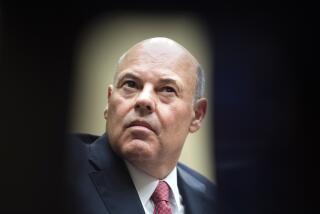U.S. Mail Delivery Speeds Up to Record Level, Study Finds
- Share via
WASHINGTON — The U.S. Postal Service is getting speedier, with first-class mail service reaching a record level of 87% for on-time delivery of scheduled overnight service, Postmaster General Marvin T. Runyon Jr. said Tuesday.
Los Angeles, New York and Washington all showed improvement during the Postal Service’s fiscal quarter ending in May, according to an independent test by the accounting firm of Price Waterhouse that tracked the delivery of first-class letters, cards and large envelopes.
Postal Service standards call for overnight delivery within a metropolitan area--a range of roughly 60 miles--for any first-class piece of mail deposited by the last collection time posted on a mailbox. Second-day delivery covers a zone out to 600 miles, and three-day delivery would apply to a letter mailed anywhere else in the United States.
The nationwide performance level of 87%, compared with 85% in the prior three months and 83% a year ago, was the highest since Price Waterhouse began its survey in the fall of 1990 under a contract with the Postal Service.
Price Waterhouse conducts the testing by “seeding” the mail with its own letters, cards and envelopes.
Additional hiring, changes in local management and increased benefits from automation all contributed to the improved delivery activity, postal officials said.
Los Angeles had an on-time delivery rate of 85% from March through May, up from 82% in the prior quarter and 80% a year earlier.
“We knew going into this quarter that we had the resources and systems to hit a grand slam,” Runyon said. “Our employees hit the ball out of the park. I am proud of what they’ve achieved.”
Some of the biggest improvements came in cities where the Postal Service came under intense criticism for inefficient and unreliable service. New York’s on-time results improved sharply, climbing to 83% from 76% in the previous quarter and 62% a year earlier. In Washington, the rate climbed to 81%, up from 75% three months earlier and 62% last year.
More to Read
Sign up for Essential California
The most important California stories and recommendations in your inbox every morning.
You may occasionally receive promotional content from the Los Angeles Times.













